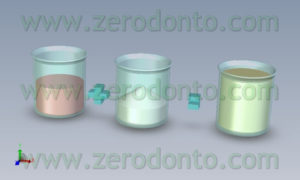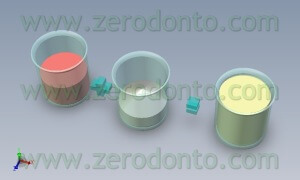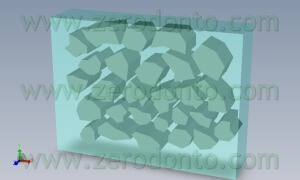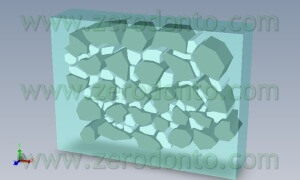Composite materials used in dentistry are made up of a fluid resin and a solid filler. The resin is made up of monomers (monomers are molecules). The solid filler is made up of glass, quartz and silicon particles. Taken alone the filler is like a fine-grained powder (silicon, quartz, glass particles powder) to the touch. Defining a composite material as macro-, micro- or nano- filled refers to the particle dimension (granulometry).
How much powder is mixed with how much resin?
The amount of filler in respect to the amount of resin is defined filler percentage. The “amount” referred to is the volume of filler and of resin. A filler percentage of 80% means that the amount of filler mixed with resin accounts for the 80% of the volume of resin alone.
PICTURE 1-2


The filler percentage varies on the different dental composites on the market.
However we can distinguish two main categories of composite materials according to their filler percentage: high filler percentage composites (about 70% in volume) and low filler percentage composites (about 50% in volume).
If every glass or quartz particle had the size of a stone, a high filler percentage composite material would look like a dry-stone wall, where the stones it is made up of are very close to each other.
Every stone has got an irregular shape: this means that it cannot fit perfectly with the adjacent stones having irregular shapes themselves. A wall only made up of “big” stones, having a given volume (Vg) but whose shape is irregular and varies from stone to stone, would have wide gaps between the stones it is made up of.
(PICTURE 3-4).

The whole wall takes up a given volume Vm: 50-60% of this is taken up by big stones all having a volume Vg. The remaining volume percentage equals the sum of all the gaps between the stones: this hollow volume is defined Vv.
In order to fill the hollow volume, that is to “fill” the hollow spaces, smaller stones (PICTURE 5) can be added among the bigger stones: adding the smaller stones will result in the creation of smaller gaps which will be filled with even smaller stones.

In the above mentioned dry-stone wall, we can figure the resin as a thin layer of glue spread on the interfaces between all the stones.
A high filler percentage composite material appears as a solid array of quartz and/or glass particles of different sizes, closely in contact to each other and with a thin layer of resin spread on the interfaces between the particles.
The definitions of macro-, micro, micro-hybrid- and nano- composite are referred to the sizes of the particles and how differently shaped particles are combined together to “fill the gaps” of the dry-stone wall.
If every glass or quartz particle had the size of a stone, a low filler percentage composite material would look like a wall whose stones are separated by a thick layer of cement.
The result of this mixture is a viscous paste. Viscosity is defined as the ability of the molecular particles a fluid is made up of to flow one upon the other. In a dental composite material viscosity depends on the friction between the molecules (monomers) flowing one upon the other, on the friction between quartz and/or glass particles flowing one upon the other and on the friction between quartz and/or glass particles flowing on the monomers. The higher the friction between particles and/or molecules, the higher the viscosity of the paste; the lower the friction between molecules and/or particles, the lower its viscosity.
A possible example can be a tube of cavit and saliva. Cavit has a higher viscosity than saliva. This is due to the higher friction between the molecules/particles of cavit and the molecules/particles of saliva.
The viscosity of a composite material in paste form (not hardened yet) depends on:
- Filler (powder)-resin volume ratio
- Resin viscosity
BIS-GMA is the resin employed as matrix in dental composites. Its high viscosity dramatically reduces its workability at room temperature. For this reason BIS-GMA is diluted adding low viscosity resins like TEGDMA.
The filler is constituted by lithium silicate, aluminum silicate, quartz and barium glasses particles.
Composites are classified according to the granulometry of the filler, that is the size of the particles.
In macro-filled composites the average dimensions of the particles range from 1 to 30 mm.
In homogeneous micro-filled composites the average dimensions of the particles range from 0.04 to 0.06 mm.
In hybrid composites the filler is made up of both 1-30 mm particles and 0.04-0.06 mm particles.
In these classes of composites the filler is simply added to the matrix.
In other kinds of composites, the very particles are made up of a composite material. This is the case with Inhomogeneous Micro-Filled Composites, which can be subdivided into:
- Micro-filled complexes reinserted into the mass, where some micro-particles are put into BIS-GMA resin; the resulting mixture is polymerized and, when hardened, ground and shred till the composite granules reach a size ranging from 1 to 200 mm; at this point the granules are put back into BIS-GMA resin to get the final composite;
- Composites micro-filled with pre-polymerized spherical particles: these micro-particles are put into spheres of partially polymerized resin, then the polymeric spheres which also contain the micro-particles are added as filler in the BIS-GMA resin to get the final composite. The composite spheres range from 20 to 30 mm;
- Microparticles agglomerate complexes: the micro-particles are aggregated in resin-free agglomerates sized 1-25 mm; then the agglomerates are put into BIS-GMA resin to get the final composite.
The microparticles are then present as granules or pre-polymerized spheres or agglomerated granules rather than individual particles. This allows to incorporate higher amounts of filler without noticeably increasing the viscosity of the material.
The adhesion of the matrix to the filler particles has improved using an organic silicon glue called silane.
Dr Davide Apicella,
was born in Naples on December 19th, 1980.
He obtained his degree in Dentistry and Prosthodontics at the Faculty of Medicine and Surgery, Second University, Naples on September 29th, 2008 with a mark of 110/110.
In the 2006/2007 Academic Year he worked as contract orthognathodontics tutor in the Master Degree in Dentistry and Prosthodontics, Faculty of Medicine and Surgery, Second University, Naples.
On November 1st, 2008 he started to attend his first year of a Ph.D. in Biomaterials in Odontostomatology and Ophthalmology – 24th cycle, Second University, Naples.
Scientific works published on journals indexed in the National Library of Medicine and having an Impact Factor:
2009: Aversa R, Apicella D, Perillo L, Sorrentino R, Zarone F, Ferrari M, Apicella A.
Non-linear vischoelastic three dimensional finite element analysis on the effect of endocrown material rigidity on alveolar bone modeling process. Dental Materials. 2009 Jan 15. (Epub ahead of print).
2008: Ferrari M, Sorrentino R, Zarone F, Apicella D, Aversa R, Apicella A. Non-Linear Visco-Elastic Finite Element Analysis of The Effect of The Length of Glass Fiber Posts on The Biomechanical Behaviour of Directly Restored Incisors and Surrounding Alveolar Bone. Dental Materials Journal. 2008 Jul;(4):485-98.
2007: Sorrentino Roberto; Salameh Ziad; Apicella Davide; Auriemma Tommaso; Zarone Fernando; Apicella Antonio; Ferrari Marco. Three-dimensional finite element analysis of stress and strain distributions in post-and-core treated maxillary central incisors. The journal of adhesive dentistry 2007;9(6):527-36. Department of Dental Materials and Restorative Dentistry, University of Siena, Policlinico Le Scotte, Siena, Italy.
2006: Annunziata Marco; Aversa Raffaella; Apicella Antonio; Annunziata Antonio; Apicella Davide; Buonaiuto Curzio; Guida Luigi. In vitro biological response to a light-cured composite when used for cementation of composite inlays. Dental materials : official publication of the Academy of Dental Materials 2006;22(12):1081-5. Department of Odontostomatological, Orthodontic and Surgical Disciplines, Second University of Naples S.U.N., Naples, Italy.
2006: Zarone Fernando; Sorrentino Roberto; Apicella Davide; Valentino Bartolomeo; Ferrari Marco; Aversa Raffaella; Apicella Antonio. Evaluation of the biomechanical behavior of maxillary central incisors restored by means of endocrowns compared to a natural tooth: a 3D static linear finite elements analysis. Dental materials : official publication of the Academy of Dental Materials 2006;22(11):1035-44. Second University of Naples, DISPAMA, Material Division, Aversa, Italy.
2005: Zarone Fernando; Apicella Davide; Sorrentino Roberto; Ferro Valeria; Aversa Raffaella; Apicella Antonio. Influence of tooth preparation design on the stress distribution in maxillary central incisors restored by means of alumina porcelain veneers: a 3D-finite element analysis. Dental materials : official publication of the Academy of Dental Materials 2005;21(12):1178-88.
2005: Apicella Antonio; Simeone Michele; Aversa Raffaella; Lanza Alessandro; Apicella Davide. Light shielding effect of overlaying resin composite on the photopolymerization cure kinetics of a resin composite and a dentin adhesive. Dental materials : official publication of the Academy of Dental Materials 2005;21(10):954-61.
2005: Lanza Alessandro; Aversa Raffaella; Rengo Sandro; Apicella Davide; Apicella Antonio. 3D FEA of cemented steel, glass and carbon posts in a maxillary incisor. Dental materials : official publication of the Academy of Dental Materials 2005;21(8):709-15.
2005: Simeone Michele; Lanza Alessandro; Rengo Sandro; Aversa Raffaella; Apicella Davide; Apicella Antonio. Inlay shading effect on the photopolymerization kinetic of a dental composite material used as bonding system in an indirect restoration technique. Dental materials : official publication of the Academy of Dental Materials 2005;21(8):689-94.
For information
Davide Apicella:
davidsail@msn.com

